


 Chess for pacifists
Chess for pacifistsDo you ever feel there is too much conflict in the world? If you do, then OTB chess – the recent Kazan Candidates aside – is possibly not the ideal thing for you, since chess is, after all, a war game. But here in the world of chess problems, we have a niche for those of you who find the sight of White and Black trying to beat each other's brains out unpalatable– the wonderful world of helpmates.
In a helpmate, the two sides cooperate, in a mutual quest to create something beautiful. Black generally moves first, and helps White to mate the black king in the required number of moves. The fact that the two sides are working together allows many beautiful and paradoxical ideas to be shown.
Peter Knienst,
4th Prize Kennst du die Bibel? 1966
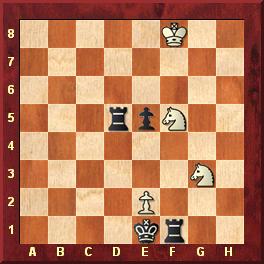
Helpmate in four
Here is a very nice, but not too complicated example. Black moves first and helps White to give mate on his fourth move. If you want a clue, here is one: if the BK stood on e4 and the Rf1 on f4, the position would already be mate, so it is just a matter of arranging that!
So, how did you get on? If you struggled, don't worry – practice makes
perfect, just as Übung macht den Meister in Germany, and after
a bit of practice, you will soon get the hang of helpmates. After the clue I
gave you, it looks as though it should be a simple way to arrange the mating
pattern, but in fact, there is only one way (of course!), and it is very pretty.
The solution runs (I remind you once again, Black moves first): 1.Kf2
Ng7 2.Ke3+ N3f5+ 3.Ke4 Nh5 4.Rf4 5 Nhg3#
Isn't that nice? The two white knights have to swap places in the course of
the solution!

And now another helpmate, by a composer whose name we met in my first column:
Matti Myllyniemi, Satakunan Kansa 1968
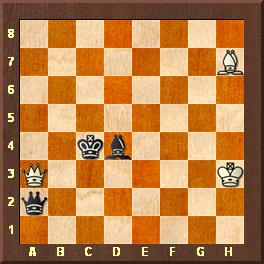
Helpmate in two – four solutions
One thing which will strike you is the stipulation, which refers to four solutions. This may seem to contradict what I stated much earlier, namely that the solution to a problem must be unique. For most problems, especially direct mates, this is indeed the case – a second solution, especially one that is unintended by the composer, would be referred to as a cook and is regarded as a fatal flaw. But multiple solutions are sometimes intended, and in helpmates, they are especially common. In most cases, there will be a strong thematic link between the different solutions, as is the case here.
Here it is a helpmate in two, so we are looking for a sequence which runs: B moves, W moves, B moves, W mates. Have a look and try to solve the problem, before reading on.
So, how did you get on? If you struggled, don't worry – practice makes perfect, just as Ubung macht den Meister in Germany, and after a bit of practice, you will soon get the hang of helpmates. The first solution (remember, Black moves first) is 1.Kd5 Qe7 2.Qc4 Be4#. Keep that mating pattern in mind, and see if you can find the second solution. No luck? It is 1.Bc3 Qd6 2.Qb3 Bd3#. Yes, indeed – the same mate as the first solution, but moved one square down the diagonal, towards the South West. You should be getting the idea by now, so try finding solution three. Yes, that's right: 1.Bb2 Qc5+ 2.Kb3 Bc2# – the same mate again, shifted another square along the diagonal! The fourth solution is slightly trickier to spot, but is worth seeing – 1.Qg2+ Kh4 2.Qd5 Bd3#. Look at that final mate again – it is the same mating position as the others, but this time rotated through 90%!
A wonderful little problem, with just six pieces on the board. And the alert reader may have spotted something else about it: as the stipulation above the diagram makes clear, this little gem did not even get a prize – they can be tough chaps to please, these problem judges!

The next position is another multi-solution helpmate, but with a twist:
Narayan Shankar Ram,
6th Honourable Mention, The Problemist 1986
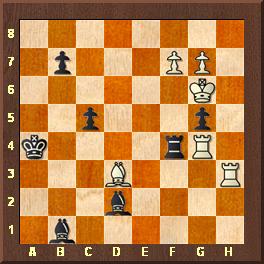
Helpmate in two – duplex
This is a duplex, which in this case has nothing to do with split-level apartments in desirable residential areas. In a duplex helpmate, we have two problems in one: in one solution, Black moves first and helps White to checkmate him, and in the other solution, starting from the same position, White moves first and helps Black mate him! Once again, have a go at solving for yourself, before you read on. I suggest you start with the Black to move solution.
Although only two moves long, the solution is not a "gimme": 1.Ba5 Be4 2.Rf5 Bc6#. Let us look at exactly what happens in this solution: Black's first move self-blocks one of his king's flights. White's first move unpins a black piece, namely the Rf4. Black's second move in turn unpins a white piece (the Be4), and White's second move sees that unpinned piece give double check and mate.
Now watch what happens in the duplex solution, where White moves first and helps Black give mate: 1.Rh5 (self-block), Re4 (unpins WB) 2.Bc4 (unpins BR) Re6 mate (double check and mate)!
Absolutely beautiful! The strategy in the two phases is exactly mirrored, a perfect exploitation of the duplex twinning method.

Now is time to introduce another problem genre: the selfmate. In a selfmate, we are back to conflict again, but with a difference: White moves first, but instead of trying to mate Black, he instead tries to force Black to mate him! Black is trying to avoid mating White. It is the chessboard equivalent of the old joke about the masochist and the sadist: the masochist says "Hurt me, hurt me!" and the sadist says "No, I won't!"
Our first selfmate this month, but it is a beauty, by a composer more famous for his endgame studies, but who was also a prolific and brilliant problemist:
Leonid Kubbel - 1st Pr Jas 1935
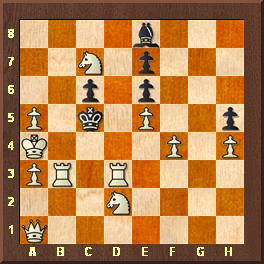
Selfmate in three
It is in the nature of selfmates that Black will usually have very few legal moves – after all, in order to force him down a narrow path to giving mate, White will inevitably need a great deal of control. Looking at the position, we can see the germ of an idea or two. For example, can we arrange for cxb5 to be mate? It looks unlikely, because the Rb3 and Nb5 can always capture on b5, whilst if the rook moves away in advance, the white king will have the square b3. Another idea is to arrange c6-c5 as discovered check and mate, but that seems even more unlikely, as White has two pieces able to interfere on b5, and the Nc7 attacks the bishop. So, do you think it impossible? Oh ye of little faith!
We kick off with 1.Rd8! This gives Black three legal moves. Let's start with 1...Bg6. Now we play 2.Qc1+ Bc2 (forced) 3.Nb5 and, lo and behold, Black's only legal move is 3 ..cxb5#, which, thanks to the fact that we have cunningly managed to force Black to pin the Rb3, is mate!
That's pretty neat in itself, but there's more. Black can instead try 1...Bf7. But now we have another way of forcing him to take control of b3: 2.Nxe6+ Bxe6 and now the trap is sprung: 3.Rb5+ cxb5#.
Finally, we turn to Black's other legal move, 1...Bd7. Now there is no chance of forcing him to take control of b3, but instead, we have another striking idea: 2.Qd4+! Kxd4 3.Kb4 and now, with his bishop pinned and his king immobile, Black's only remaining legal move is 3...c5#.

Fantastic, I hope you agree? And surely a welcome change from spending all of one's chess leisure time trying to find a microscopic edge on move 25 of the Russian Defence? If you agree, here is another selfmate to get your choppers into:
Knud Hanneman, Tijdschrift N I S B 1931
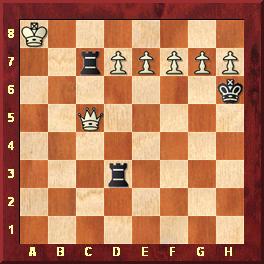
Selfmate in four
Here, the basic mating idea looks clear enough – somehow, we have to arrange to force Rxd8 mate. But how exactly? Over to you! But what's this – you want a clue? Well, if you are a German speaker, I can just whisper the word Allumwandlung, and that should be all you need. And for those of you who do not speak German, I could just be nasty and recommend Google Translate, but instead I will ask you a question: how many pieces can a pawn on the 7th promote to in a game of chess?
I hope the clue was enough, but don't despair if it wasn't! The spectacular solution is 1.h8Q+ Kg6 2.g8R+ Kxf7 3.e8B+ Ke6 4.d8N+ Rxd8#. Yes, indeed – the white pawns promote in turn to each of the four possible pieces. This theme is a common one in problems (and even in some studies), known by the German word Allumwandlung, or "all promotions".
Well, that is all for now. I will be back in a couple of weeks, with more on the wonderful world of the chess problem. See you then!

| Link: The British Chess Problem Society |